Anatomy Addition Knowledge Points
1/22
There's no tags or description
Looks like no tags are added yet.
Name | Mastery | Learn | Test | Matching | Spaced |
|---|
No study sessions yet.
23 Terms
Anatomy of the Ear
What is the avg length of the female urethra
The average length of the female urethra is 1 to 1.5 inches.
Different Between Tendon & Ligament
Which one attaches muscle to bone?
Feature | Tendon 筋/腱 | Ligament 韧带 |
|---|---|---|
Function | Tendon 筋/腱 Connects muscle to bone | Ligament 韧带Connects bone to bone |
Made of | Tough, fibrous connective tissue | Similar fibrous tissue, slightly more elastic |
Flexibility | Less elastic (more rigid) | More elastic (allows some joint movement) |
Location | Found at the end of muscles | Found in joints (e.g., knee, ankle) |
Purpose | Helps move the bone when muscles contract | Stabilizes and supports joints |
Healing speed | Slower due to poor blood supply | Also slow, but slightly better than tendons |
Which of the following is the function of surfactant in the alveoli of the lungs?
✅ Reduce surface tension
What Surfactant Does:
Surfactant is a lipid-protein substance secreted by alveolar cells (type II pneumocytes).
It coats the inner surface of the alveoli (tiny air sacs in the lungs).
By reducing surface tension, it:
Prevents alveoli from collapsing during exhalation
Makes it easier for the lungs to expand during inhalation
Improves gas exchange efficiency
🚨 Without surfactant:
The alveoli would collapse due to the high surface tension of water lining them.
Breathing would require much more effort, and oxygen exchange would be impaired.
🧠 In summary:
Surfactant reduces surface tension in the alveoli, making breathing easier and preventing alveolar collapse.
which of the following is associated with wound healing by primary intention?
Minimal scar tissue is associated with wound healing by primary intention.
Wound Healing by Primary Intention:
This occurs when the wound edges are clean, closely approximated (brought together), like in a surgical incision or a clean cut.
The wound is usually small and shallow.
Healing happens quickly because the tissues can easily reconnect.
There is minimal tissue loss.
Minimal scar tissue forms because the wound heals neatly and directly without large gaps.
Summary:
Healing Type | Wound Edges | Scar Tissue | Example |
|---|---|---|---|
Primary Intention | Edges are close | Minimal scar | Surgical cuts, paper cuts |
Secondary Intention | Edges are apart | Larger scar | Large wounds, ulcers |
Hormones or enzyme that involved in fluid balance and is produced by the kidneys.
What is Renin? 肾素
Renin is an enzyme secreted by the juxtaglomerular cells in the kidneys.
It is released in response to:
Low blood pressure
Low sodium levels
Sympathetic nervous system activation
Role of Renin:
Renin starts the Renin-Angiotensin-Aldosterone System (RAAS).
It converts angiotensinogen (produced by the liver) into angiotensin I.
Angiotensin I is then converted to angiotensin II (a powerful vasoconstrictor), which:
Raises blood pressure by narrowing blood vessels.
Stimulates the release of aldosterone from the adrenal glands.
Aldosterone increases sodium and water reabsorption by the kidneys, increasing blood volume and pressure.
Summary:
Renin | Function |
|---|---|
Enzyme | Initiates RAAS to regulate blood pressure and fluid balance. |
Mitosis & Meiosis
Feature | Mitosis | Meiosis |
|---|---|---|
Purpose | Growth, repair, and asexual reproduction | Production of gametes (sperm and eggs) |
Number of divisions | One division | Two divisions |
Number of daughter cells | 2 daughter cells | 4 daughter cells |
Chromosome number in daughter cells | Same as parent (diploid, 2n) | Half of parent (haploid, n) |
Genetic variation | Daughter cells are genetically identical | Daughter cells are genetically different (crossing over and independent assortment) |
Where it occurs | Most body cells | Gonads (testes and ovaries) |
Quick summary:
Mitosis = one division → 2 identical diploid cells → body growth and repair.
Meiosis = two divisions → 4 genetically unique haploid cells → sexual reproduction.
有丝分裂
Literally means “division with threads,” referring to the thread-like chromosomes during cell division.
Meiosis = 减数分裂
Literally means “reduction division,” referring to the halving of chromosome number.
Sperm and ova production are the result of the process of meiosis.
Cerumen and Sebum in ears
Substance | Produced By | Location | Function |
|---|---|---|---|
Cerumen /səˈro͞omən/耳垢 | Ceruminous glands | Ear canal | Traps dust, dirt, microbes; protects ear; prevents drying; antibacterial |
Sebum 皮脂 | Sebaceous glands | Skin and hair follicles | Moisturizes and waterproofs skin and hair; protects against bacteria and fungi |
Which of the following is a site of sperm maturation in the male reproductive system
Epididymis
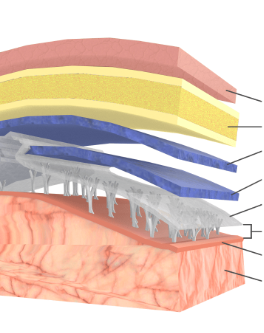
Identify Meningeal Layers
The correct order of the protective meningeal layers of the brain from inside to outside is:
Pia mater (closest to the brain surface)
Arachnoid mater
Dura mater (outermost layer)
Quick explanation:
Pia mater is a thin, delicate layer that directly covers the brain tissue.
Arachnoid mater is a web-like middle layer.
Dura mater is a tough, durable outer layer that protects the brain and spinal cord.
Tips for Memorizing Meningeal Layers (Inside to Outside)
PAD (Pia, Arachnoid, Dura)
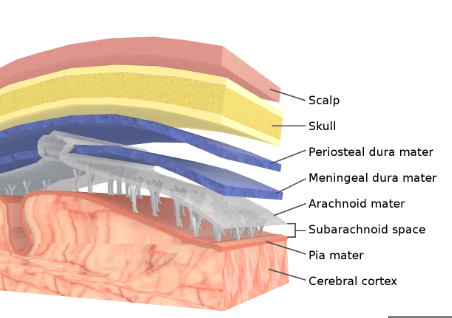
How does Potassium associated with Cardiac Arrthmias?
📝 Sample TEAS-Style Questions
1. What role does potassium play in cardiac muscle function?
a) Initiates red blood cell production
b) Regulates electrical signals in heart muscle cells
c) Maintains blood sugar balance
d) Produces cardiac enzymes
2. Which of the following potassium imbalances is most likely to cause ventricular fibrillation or tachycardia?
a) Hypernatremia
b) Hypercalcemia
c) Hypokalemia
d) Hypoglycemia
3. A patient with hyperkalemia is most at risk for:
a) Increased urine output
b) Irregular heart rhythm or cardiac arrest
c) Muscle cramps only
d) Low blood sugar
Potassium (K⁺) plays a critical role in heart function, especially in maintaining a normal heart rhythm. When potassium levels become too high or too low, it can lead to cardiac arrhythmias (irregular heartbeats).
How Potassium Affects the Heart:
Potassium is essential for:
Electrical signaling in cardiac muscle cells
Maintaining the resting membrane potential
Allowing the heart muscle to contract and relax properly
⚖ Imbalance of Potassium = Risk of Arrhythmias
Potassium Level | Medical Term | Effect on the Heart | Possible Arrhythmias |
|---|---|---|---|
Too low | Hypokalemia | Cells become more excitable, delayed repolarization | PVCs, atrial fibrillation, ventricular tachycardia |
Too high | Hyperkalemia | Slows conduction, can stop the heart if severe | Bradycardia, heart block, asystole, VFib |
🧠 In Simple Terms:
Low potassium = heart is too excitable → fast or irregular beats
High potassium = heart is too slow or stops → dangerous or fatal rhythm
🔁✅ Correct Answers Table
Question | Correct Answer |
|---|---|
1 | b) Regulates electrical signals in heart muscle cells |
2 | c) Hypokalemia |
3 | b) Irregular heart rhythm or cardiac arrest |
HOW MUCH URINE DOES A NORMAL ADULT BLADDER HOLDS?
A normal adult bladder can comfortably hold about:
✅ 400 to 600 milliliters (mL) of urine
— before the strong urge to urinate is felt.
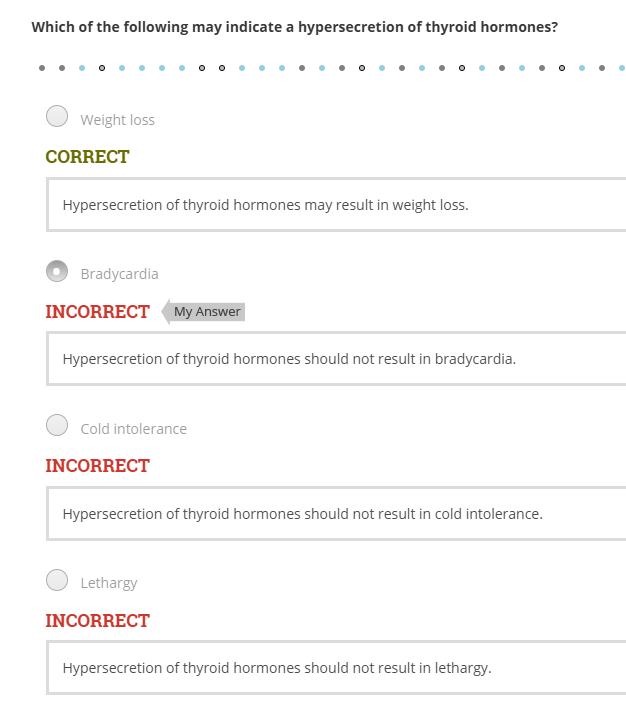
Condition | Thyroid Hormone Level | Typical Symptoms |
|---|---|---|
Hyperthyroidism | ? | ? |
Hypothyroidism | ? | ? |
🧠 Correct Answer: Weight loss
Why?
Hyperthyroidism increases metabolic rate, which causes the body to burn calories faster—even at rest—leading to weight loss, often despite a normal or increased appetite.
❌ Incorrect Options Explained:
Option | Why It’s Incorrect for Hyperthyroidism |
|---|---|
Bradycardia | This is a slow heart rate. Hyperthyroidism usually causes tachycardia (fast HR). |
Cold intolerance | Seen in hypothyroidism. People with hyperthyroidism are often heat intolerant. |
Lethargy | Common in hypothyroidism, not hyperthyroidism. Hyperthyroid patients often feel anxious, restless, or jittery. |
📝 Summary Table:
Condition | Thyroid Hormone Level | Typical Symptoms |
|---|---|---|
Hyperthyroidism | High | Weight loss, fast heart rate, heat intolerance, anxiety |
Hypothyroidism | Low | Weight gain, slow heart rate, cold intolerance, fatigue |
🔍 TEAS-Style Multiple Choice Example:
Which of the following electrolytes is essential for blood clotting?
a) Sodium (Na⁺)
b) Potassium (K⁺)
c) Calcium (Ca²⁺)
d) Chloride (Cl⁻)
🩸 Why Calcium?
Calcium plays a crucial role in blood clotting by:
Activating clotting factors in the coagulation cascade
Helping convert prothrombin to thrombin, a key step in forming a clot
Stabilizing the structure of fibrin (the protein mesh that forms the actual clot)
✅ Correct Answer: c) Calcium (Ca²⁺)
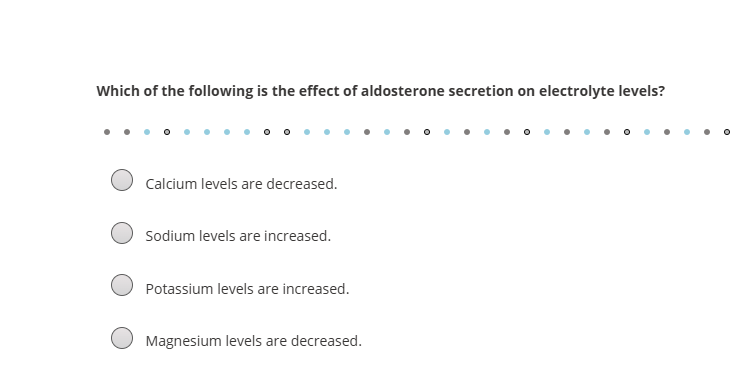
📝 Sample TEAS-Style Questions on Aldosterone
1. What is the main effect of aldosterone on electrolyte levels in the kidneys?
a) Decreases sodium reabsorption
b) Increases potassium reabsorption
c) Increases sodium reabsorption and potassium excretion
d) Increases calcium levels
2. Which hormone is responsible for increasing sodium retention and helping raise blood pressure?
a) Insulin
b) Aldosterone
c) Cortisol
d) Parathyroid hormone
3. A patient with excessive aldosterone secretion would likely have:
a) High potassium levels
b) Low sodium levels
c) Increased sodium retention and decreased potassium
d) Increased urine output
🧠 Why?
Aldosterone is a hormone secreted by the adrenal cortex. Its main effect on electrolytes is:
✅ Increases sodium (Na⁺) reabsorption in the kidneys
Increases potassium (K⁺) excretion
💧 Helps retain water, increasing blood volume and pressure
❌ Why the Other Options Are Incorrect:
Option | Explanation |
|---|---|
Calcium levels are decreased | Aldosterone does not directly affect calcium levels |
Potassium levels are increased | Aldosterone actually causes potassium loss, not gain |
Magnesium levels are decreased | Not a direct effect of aldosterone |
📝 Quick Summary:
Electrolyte | Aldosterone Effect |
|---|---|
Sodium (Na⁺) | ⬆ Increased reabsorption |
Potassium (K⁺) | ⬇ Increased excretion |
✅ Correct Answers Table
Question | Correct Answer |
|---|---|
1 | c) Increases sodium reabsorption and potassium excretion |
2 | b) Aldosterone |
3 | c) Increased sodium retention and decreased potassium |
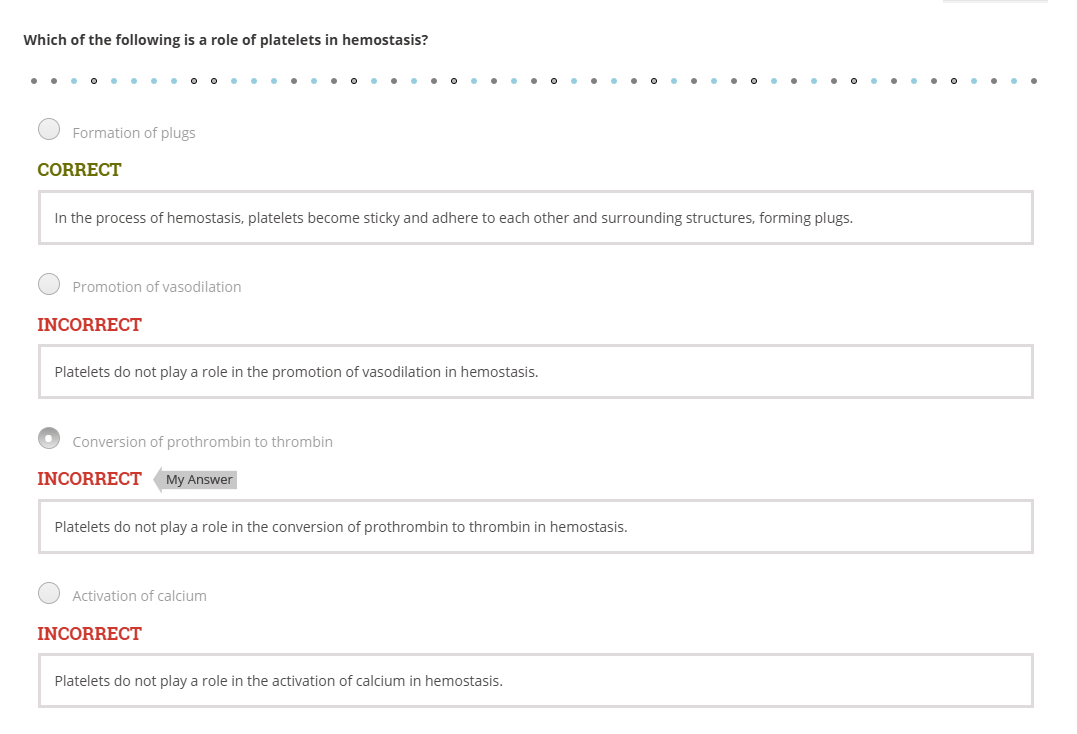
📝 Sample TEAS-Style Questions
1. What is the primary role of platelets in hemostasis?
a) Promote vasodilation
b) Convert prothrombin to thrombin
c) Form plugs at the site of blood vessel injury
d) Activate calcium for clotting
2. Platelets help stop bleeding by:
a) Breaking down blood clots
b) Forming sticky plugs to seal damaged vessels
c) Increasing blood pressure
d) Dilating blood vessels
3. Which process is not directly performed by platelets?
a) Adhering to damaged vessels
b) Activating clotting factors like calcium
c) Forming a platelet plug
d) Aggregating with other platelets
🩸 Correct Answer:
Formation of plugs — Platelets become sticky and adhere to each other and to damaged vessel walls, forming a platelet plug to help stop bleeding.
❌ Why the other options are incorrect:
Option | Explanation |
|---|---|
Promotion of vasodilation | Platelets promote vasoconstriction, not dilation, to reduce blood flow. |
Conversion of prothrombin to thrombin | This is done by clotting factors, not directly by platelets. |
Activation of calcium | Calcium activation is part of the clotting cascade, but platelets do not activate calcium. |
✅ Correct Answers Table
Question | Correct Answer |
|---|---|
1 | c) Form plugs at the site of blood vessel injury |
2 | b) Forming sticky plugs to seal damaged vessels |
3 | b) Activating clotting factors like calcium |
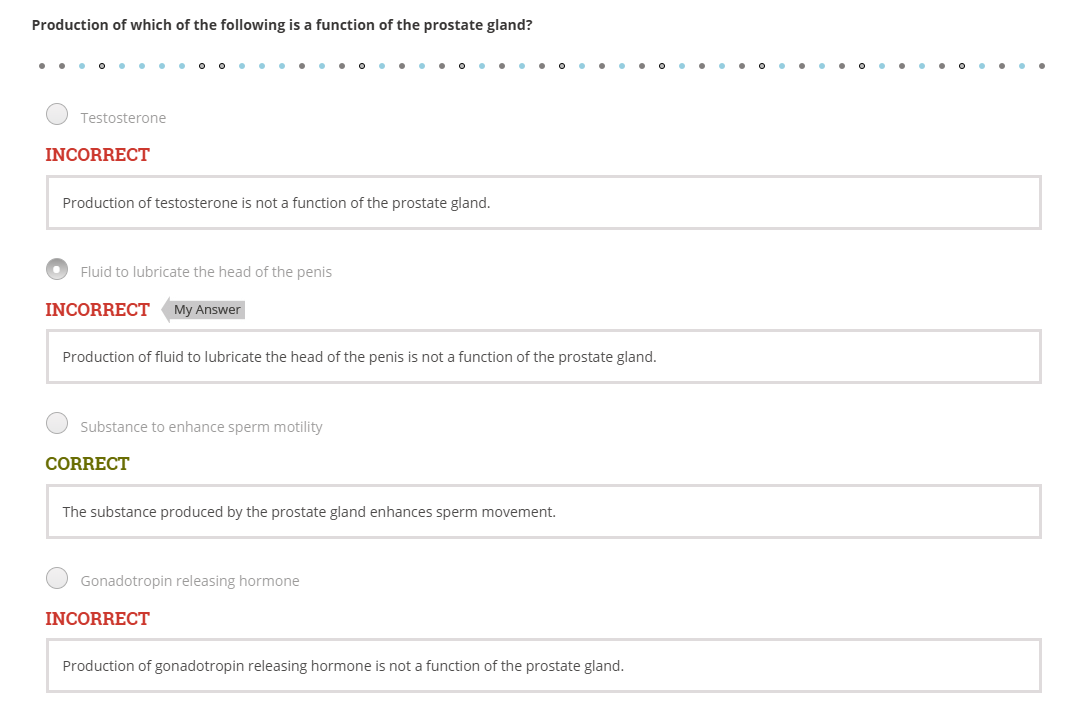
📝 Sample TEAS-Style Questions
1. What is a primary function of the prostate gland?
a) Produce testosterone
b) Produce fluid to lubricate the head of the penis
c) Produce substances that enhance sperm motility
d) Produce gonadotropin releasing hormone
2. Which gland produces fluid that helps sperm move better?
a) Prostate gland
b) Testes
c) Bulbourethral gland
d) Hypothalamus
3. Testosterone is produced by which of the following?
a) Prostate gland
b) Testes
c) Pituitary gland
d) Adrenal gland
✅ Correct Answer:
Substance to enhance sperm motility — The prostate gland produces fluid that helps sperm move better (increases sperm motility) and contributes to semen.
❌ Why the other options are incorrect:
Option | Explanation |
|---|---|
Testosterone | Produced by the testes, not the prostate gland. |
Fluid to lubricate the head of the penis | Produced by the bulbourethral glands, not the prostate. |
Gonadotropin releasing hormone | Produced by the hypothalamus, not the prostate gland. |
📝 Summary Table:
Structure | Primary Function |
|---|---|
Prostate gland | Produces fluid to enhance sperm motility |
Testes | Produce testosterone |
Bulbourethral glands | Produce lubrication fluid for the penis head |
Hypothalamus | Produces gonadotropin releasing hormone (GnRH) |
✅ Correct Answers Table
Question | Correct Answer |
|---|---|
1 | c) Produce substances that enhance sperm motility |
2 | a) Prostate gland |
3 | b) Testes |

Blood Types Overview:
Possible TEAS Exam Questions:
# | Question |
|---|---|
1 | Which blood type can receive blood only from the same blood type? |
2 | What antigens are present on type AB blood? |
3 | Why can type O blood be given to any other blood type? |
4 | Which antibodies are found in the plasma of type A blood? |
5 | Who is the universal recipient of blood? |
6 | Why can't a person with type O blood receive type A blood? |
7 | Which blood type contains no A or B antigens on red blood cells? |
Blood Types Overview:
Humans have four main blood types based on the presence or absence of specific antigens on the surface of red blood cells:
Blood Type | Antigens on RBCs | Antibodies in Plasma |
|---|---|---|
A | A antigen | Anti-B antibodies |
B | B antigen | Anti-A antibodies |
AB | A and B antigens | No anti-A or anti-B antibodies |
O | No antigens | Anti-A and Anti-B antibodies |
Compatibility:
Type A: Can receive blood from A or O (because O has no antigens, so it won't cause a reaction)
Type B: Can receive blood from B or O
Type AB: Universal recipient, can receive blood from A, B, AB, or O (no antibodies to attack any antigen)
Type O: Can receive only O blood because it has both anti-A and anti-B antibodies, which will attack A or B antigens from other types.
Why can individuals with type O blood receive only O blood?
Type O blood cells have no A or B antigens, but their plasma contains both anti-A and anti-B antibodies.
If a person with type O blood receives A, B, or AB blood, their antibodies will attack the donor blood cells causing a dangerous immune reaction.
Therefore, type O individuals are "universal donors" but can only receive type O blood.
Correct Answers Table:
# | Correct Answer |
|---|---|
1 | Type O blood |
2 | Both A and B antigens |
3 | Because type O blood has no A or B antigens |
4 | Anti-B antibodies |
5 | Type AB blood |
6 | Because type O blood has anti-A antibodies |
7 | Type O blood |
Which structures of the GI system absorbs Iron and Bile Salts?
Ileum
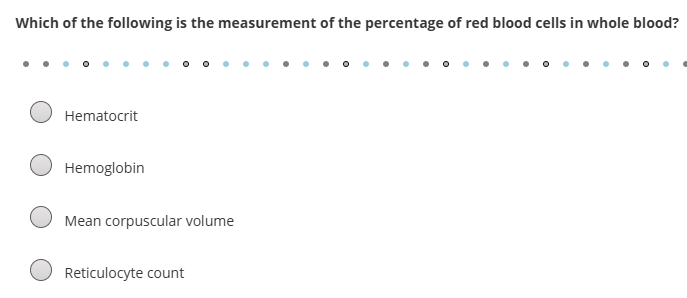
Which of the following is the measurement of the percentage of red blood cells in whole blood?
Explanation of the terms:
Term | Definition |
|---|---|
Hematocrit | The percentage of red blood cells (RBCs) in the total volume of blood. This measures how much of the blood is made up of RBCs. For example, a hematocrit of 40% means 40% of the blood volume is RBCs. |
Hemoglobin | The protein inside red blood cells that carries oxygen. Measured in grams per deciliter (g/dL) in blood tests. It shows how much oxygen-carrying protein is present. |
Mean corpuscular volume (MCV) | The average size (volume) of individual red blood cells. It helps classify types of anemia but is not a percentage. |
Reticulocyte count | The number or percentage of immature red blood cells (reticulocytes) in the blood. Indicates how fast the bone marrow is producing new RBCs. |
Summary:
The correct answer is Hematocrit because it directly measures the percentage of red blood cells in whole blood.
Hemoglobin measures oxygen-carrying capacity, not the percentage.
MCV measures cell size, not the percentage.
Reticulocyte count measures immature cells, not the percentage of total RBCs.